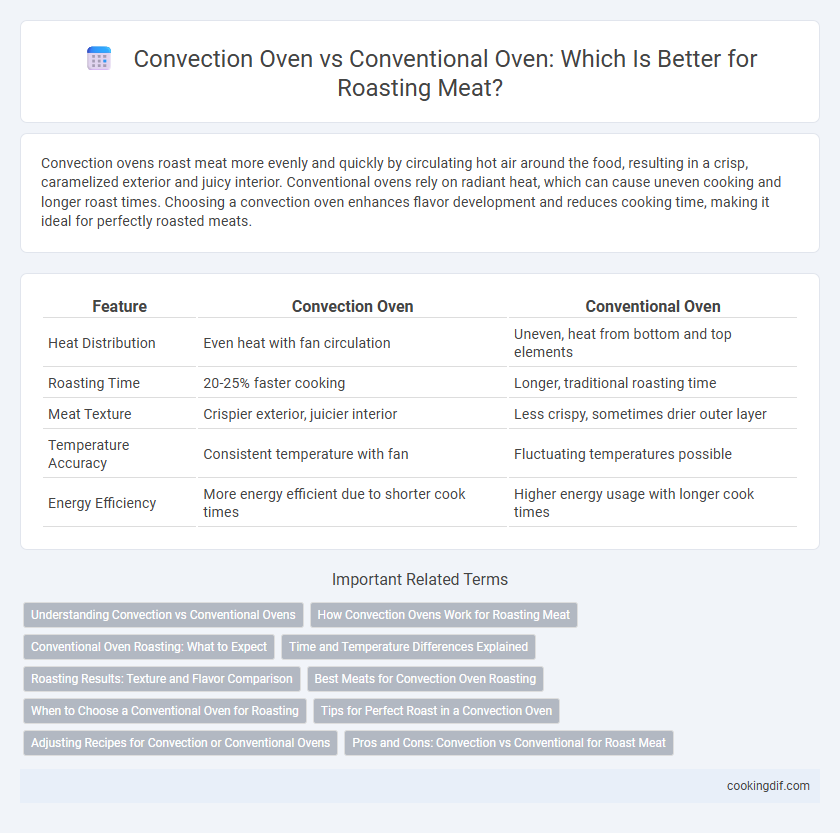Convection ovens roast meat more evenly and quickly by circulating hot air around the food, resulting in a crisp, caramelized exterior and juicy interior. Conventional ovens rely on radiant heat, which can cause uneven cooking and longer roast times. Choosing a convection oven enhances flavor development and reduces cooking time, making it ideal for perfectly roasted meats.
Table of Comparison
| Feature | Convection Oven | Conventional Oven |
|---|---|---|
| Heat Distribution | Even heat with fan circulation | Uneven, heat from bottom and top elements |
| Roasting Time | 20-25% faster cooking | Longer, traditional roasting time |
| Meat Texture | Crispier exterior, juicier interior | Less crispy, sometimes drier outer layer |
| Temperature Accuracy | Consistent temperature with fan | Fluctuating temperatures possible |
| Energy Efficiency | More energy efficient due to shorter cook times | Higher energy usage with longer cook times |
Understanding Convection vs Conventional Ovens
Convection ovens use a fan to circulate hot air, promoting even cooking and faster roasting of meat by reducing hot spots and maintaining consistent temperatures. Conventional ovens rely on radiant heat from elements at the top and bottom, which can result in uneven cooking and longer roasting times. Understanding the airflow and heat distribution differences helps optimize meat roasting for desired texture and juiciness.
How Convection Ovens Work for Roasting Meat
Convection ovens roast meat by circulating hot air evenly around the food using a built-in fan and exhaust system, resulting in faster and more uniform cooking. This consistent airflow promotes better browning and crisping of the meat's exterior while retaining juiciness inside. The enhanced heat transfer reduces cooking time compared to conventional ovens, making convection ovens ideal for roasting meats efficiently.
Conventional Oven Roasting: What to Expect
Conventional oven roasting uses radiant heat from the top and bottom elements, creating a consistent environment ideal for evenly cooking large cuts of meat. This method allows for the Maillard reaction to develop a rich, caramelized crust while retaining juicy, tender interiors. Expect longer cooking times compared to convection ovens, but with well-balanced browning and moisture preservation that enhances the meat's natural flavor.
Time and Temperature Differences Explained
Convection ovens roast meat faster by circulating hot air evenly, allowing for lower temperatures typically around 25degF less than conventional ovens, which rely on radiant heat and longer cooking times. This fan-assisted airflow reduces cooking time by up to 25%, enhancing browning and crispness without drying the meat. Conventional ovens require higher temperatures and longer durations to achieve similar results, often leading to uneven cooking and increased moisture loss.
Roasting Results: Texture and Flavor Comparison
Convection ovens circulate hot air evenly, resulting in a crispier exterior and juicier interior for roasted meat by promoting faster and more uniform cooking. Conventional ovens tend to cook more slowly, which can produce a tender texture but may lack the enhanced caramelization and depth of flavor achieved with convection heat. For rich browning and a savory crust, convection roasting typically outperforms conventional methods, offering superior texture and intensified flavor in meats like beef, pork, and poultry.
Best Meats for Convection Oven Roasting
Convection ovens excel at roasting meats with higher fat content like pork shoulder, whole chickens, and prime rib, as the circulating hot air ensures even browning and crispy skin. Lean cuts such as beef tenderloin and pork loin also benefit from convection roasting, which enhances caramelization while maintaining juiciness inside. The consistent heat distribution in convection ovens reduces cooking time by up to 25%, making them ideal for roasting large cuts of meat to perfection.
When to Choose a Conventional Oven for Roasting
Conventional ovens provide consistent radiant heat ideal for roasting large cuts of meat that benefit from slow, even cooking to develop a tender, juicy interior and a crispy exterior. Choose a conventional oven when roasting prime rib or whole poultry, as the steady temperature helps to maintain moisture and achieve a uniform browning without drying out the meat. This method is preferable for recipes requiring longer cooking times at moderate temperatures to enhance flavor and texture.
Tips for Perfect Roast in a Convection Oven
For perfect roast in a convection oven, lower the temperature by 25degF compared to conventional ovens to prevent overcooking while maintaining moisture. Use a meat thermometer to monitor internal temperature, ensuring precise doneness and optimal juiciness. Position the roast on a rack in a shallow pan to allow even air circulation and achieve a crispy, golden-brown crust.
Adjusting Recipes for Convection or Conventional Ovens
Roasting meat in a convection oven requires lowering the temperature by 25degF and reducing cooking time by about 25% compared to conventional ovens to achieve optimal browning and even cooking. Conventional oven recipes often need adjustment for longer cooking times and higher temperatures to ensure the meat reaches the desired internal temperature. Accurate temperature control and monitoring with a meat thermometer are essential for both methods to prevent overcooking or undercooking.
Pros and Cons: Convection vs Conventional for Roast Meat
Convection ovens use a fan to circulate hot air, resulting in faster and more even cooking, which enhances the browning and crispiness of roast meat. Conventional ovens rely on radiant heat, offering more traditional, slower cooking that can produce juicier, tender meat but may result in uneven heat distribution. While convection ovens save time and improve texture, conventional ovens provide better control over moisture retention, making each option suitable depending on desired roast characteristics.
Convection Oven vs Conventional Oven for roasting meat Infographic

 cookingdif.com
cookingdif.com